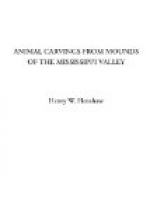“The paroquet is essentially a southern bird, and though common along the Gulf, is of rare occurrence above the Ohio River.” The above language would seem to admit of no doubt as to the fact of the decided resemblance borne by this carving to the paroquet. Yet the bird thus positively identified as a paroquet, upon which identification have, without doubt, been based all the conclusions that have been published concerning the presence of that bird among the mound sculptures is not even distantly related to the parrot family. It has the bill of a raptorial bird, as shown by the distinct tooth, and this, in connection with the well defined cere, not present in the paroquet, and the open nostril, concealed by feathers in the paroquet, places its identity as one of the hawk tribe beyond doubt.
[Illustration: Fig. 19.—Paroquet of Squier and Davis.]
In fact it closely resembles several of the carvings figured and identified as hawks by the above authors, as comparison with figures given below will show. The hawks always appear to have occupied a prominent place in the interest of our North American Indians, especially in association with totemic ideas, and the number of sculptured representations of hawks among the mound relics would argue for them a similar position in the minds of the Mound-Builders.
A word should be added as to the distribution of the paroquet. The statement by Squier and Davis that the paroquet is found as far north as the Ohio River would of itself afford an easy explanation of the manner in which the Mound-Builders might have become acquainted with the bird, could their acquaintance with it be proved. But the above authors appear to have had a very incorrect idea of the region inhabited by this once widely spread species. The present distribution, it is true, is decidedly southern, it being almost wholly confined to limited areas within the Gulf States. Formerly, however, it ranged much farther north, and there is positive evidence that it occurred in New York, Pennsylvania, Ohio, Illinois, Indiana, Michigan, and Nebraska. Up to 1835 it was extremely abundant in Southern Illinois, and, as Mr. Ridgway informs the writer, was found there as late as 1861. Specimens are in the Smithsonian collection from points as far north as Chicago and Michigan. Over much of the region indicated the exact nature of its occurrence is not understood, whether resident or a more or less casual visitor. But as it is known that it was found as far north as Pennsylvania in winter it may once have ranged even farther north than the line just indicated, and have been found in Southern Wisconsin and Minnesota.
Occurring, as it certainly did, over most of the mound region, the peculiar habits of the paroquet, especially its vociferous cries and manner of associating in large flocks, must, it would seem, have made it known to the Mound-Builders. Indeed from the ease with which it is trapped and killed, it very probably formed an article of food among them as it has among the whites and recent tribes of Indians. Probable, however, as it is that the Mound-Builders were well acquainted with the paroquet, there appears to be no evidence of the fact among their works of art.




